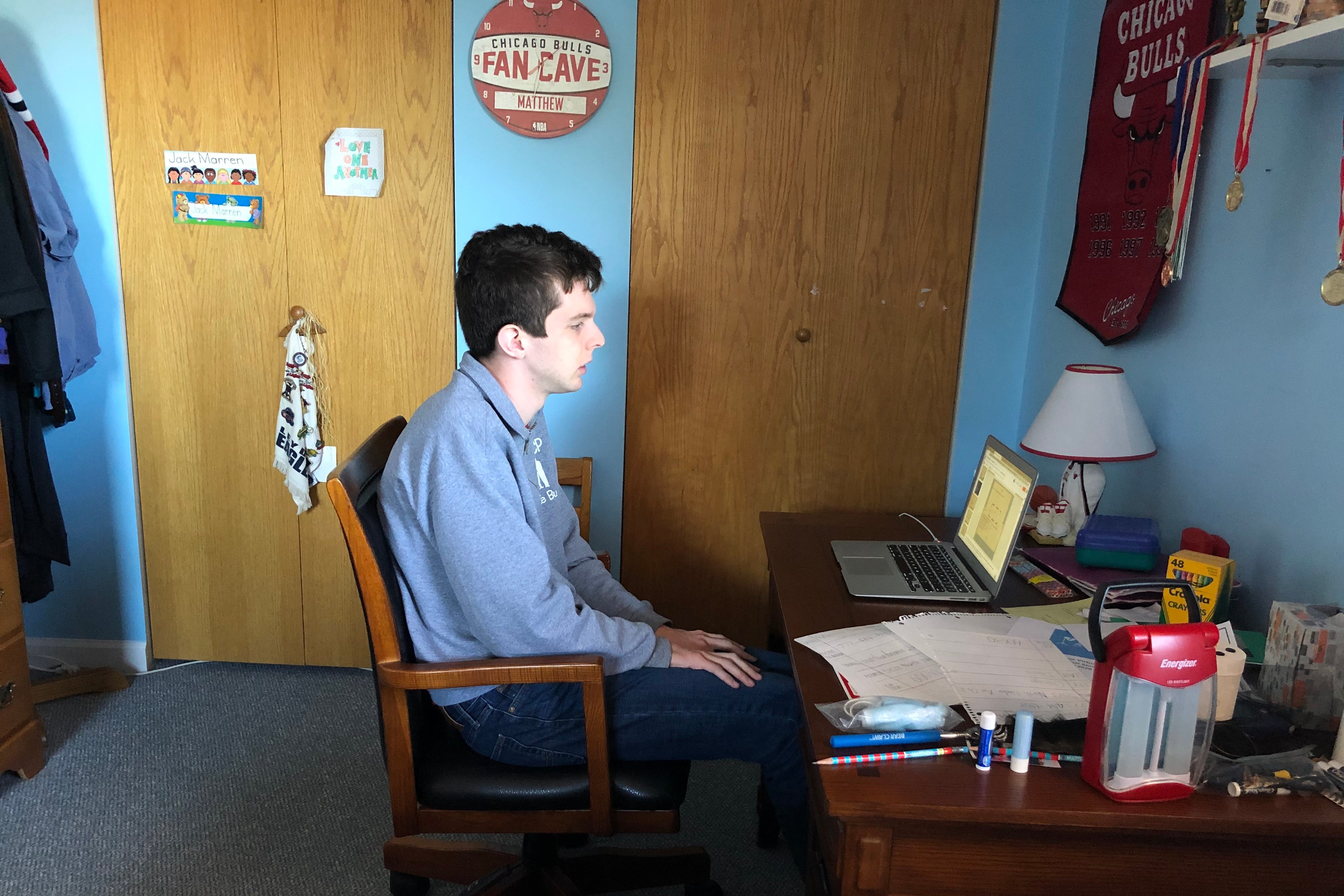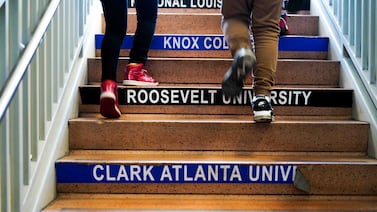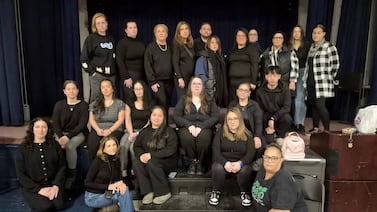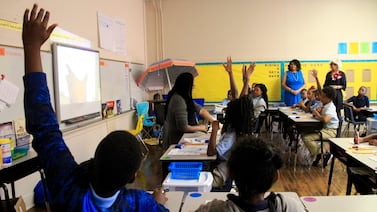When his Chicago school closed in March, Matthew Marren, a 21-year-old with autism, was entering the last year of his education, a critical time for many students with special needs.
As part of a transitional program at Vaughn Occupational High School, Marren had been able to take classes at a community college, complete an internship, and practice using public transportation and ordering food at a restaurant.
The pandemic changed all of that. Students like Marren lost four months of transitional programming, and there is no way to know if they will be able to recoup that time. In Illinois, students with special needs can receive services until the day before they turn 22.
For Marren, that day comes next April.
Advocates have been pushing the state to consider allowing students to continue their education until the end of this school year. Under the current rules, there’s no way for them to make up for the lost time.
That’s something a small but passionate group of advocates and legislators want to press the state to change. But their efforts could get drowned out by the noise of the pandemic and the state budget, as happened in the spring. During the last legislative session, both the state House and Senate weighed bills that would have extended programming for young adults until the end of the school year. But those efforts were sidelined by a short session that focused on a response to the coronavirus pandemic and emergency changes to the state’s budgets.
Beyond legislation, the coronavirus pandemic has overshadowed other efforts to improve special education services for students.
In the meantime, Marren and other 21-year-old students face a stark deadline: the abrupt disruption of the transitional programming that is supposed to launch them into adulthood.
Meghan Maureen Burke, an associate professor of special education at the University of Illinois at Urbana-Champaign, said without proper preparation for adults with disabilities to live independently, there can be tragic outcomes.
“We see that youth with disabilities compared to their peers without disabilities have worse employment outcomes. They’re less likely to be employed. They are less likely to attend college. If they do attend college they’re more likely to drop out of college,” she said.
Advocates want more support
For school leaders like Joshua Long, principal of Southside Occupational High School, the awkward cut-off time means that school leaders are unable to help students plan for their future.
“You, I, our parents, we knew when we were going to finish high school from the moment we entered. That allows for everyone, including us and our school counselors, to plan resources for our next move. Whether we were going to college or the military,” said Long.
Without the ability to plan next steps, young adults with disabilities are left in limbo and parents have to figure out what will be the best opportunity for their child. The gap between transitional programs and adult programs has been a problematic one for years, advocates and parents say. The state’s health services department is supposed to connect young disabled adults with opportunities for vocational career training, employment, and higher education — but often, those connections aren’t made.
“For youth aging out, we’d like to see them be able to receive adult services immediately so that they’re able to have support if they’re going to work in the community or to move into a group home, if that was what’s appropriate, or to move into the community with appropriate support,” said Burke.
Burke said the state’s system to connect young adults to adult service is broken. A waitlist called “prioritization of unmet need for services,” or the PUNS list, has over 20,000 people waiting for home and community based services. Young adults with disabilities wait for years to be moved off the waiting list.
The disability advocacy organization Equip for Equality filed a lawsuit in 2005 — one that is still winding its way through the legal system — over the waiting list, essentially forcing the state to reduce waiting time and meet annual commitments.
“It was 3,000 people in the first six years and after that, the list would continue to move at a reasonable pace. We’ve negotiated with the state that that’s going to be moving somewhere between 600 and 650 people each year,” said Barry Taylor, vice president for civil rights and systemic litigation at Equip for Equality.
Lauren Miller, a lawyer at Equip for Equality, added, “We still expect that when people graduate age 22, if they want developmental disability services, they are still going to have to wait. But, we hope that within the next two to three years that the gap will be, if not gone, close to being gone.”
Federal law requires states to implement services for students with disabilities up until the age of 21, but the law provides states with flexibility on when to end services.
Ron Hager, an attorney at the National Disability Rights Network, a national nonprofit special education advocacy organization, said that across the nation there is a range of when states end transitional services. For example, Hawaii and Connecticut end special education services at age 18, arguing that since general education ends at 18 they don’t have to provide additional services to students with disabilities — this was dismissed by court order and they have to provide services up to 22. Michigan is a rare example of a state that provides services up to the age of 26.
Hager says that the focus should not be only on when students end transitional services, but what programs are available to them when they do.
Although the pandemic has placed a strain on the state’s future budget, Burke said there are ways the state can help families with young adults with disabilities, such as providing families with information about their options and using the PUNS list as a planning tool for the next year.
“The PUNS list should be a pulse on the state of the need for adult services. So it’s telling you people currently need services but it’s also telling you people who are going to need services in the future. If we use that as an index of what to plan for and what the state is going to need in the future to meet the needs of all these families,” she said.
Uncertainty amid pandemic
Stephen Toy is a 22 year old with multiple disabilities who lives in a town north of Chicago. Toy turned 22 on Aug. 1. Since the coronavirus pandemic halted services, he has been at home.
His mother, Christine Toy, has tried to create a schedule for him.
“It’s figuring out what his day looks like otherwise he is watching TV or on his computer the entire day. It’s planning a schedule, when he gets up he needs to wash up, eat breakfast, afterwards we have him doing some academic things. Then we’ve created some leisure time for him to do and he’s allowed to have a certain amount of technology time,” she said.
Christine Toy is looking for vocational training for her son, with the goal of him finding a job, like working at a local grocery store. Some programs are open, but Toy is concerned about exposing her family to the coronavirus.
She said the struggle to get adult services once a student phases out of transitional programs is hard for parents.
“I think that’s the hardest struggle. Our school district tries to help us out with that but even then they are not experts,” she said.
She continued, “I think sometimes it’s difficult for families to envision what’s going to happen going forward. Even if we went through the process with Stephen it’s hard to visualize what that’s going to look like for your child.”
Matthew Marren has a little more time. His last day of school will be April 14, the day before his 22nd birthday.
Since school started in the fall, Marren wakes up at 7:30 a.m. instead of 6 a.m., which gives him enough time to eat and do his usual morning routine. Classes start at 8:15 a.m. Marren has a 10-15 minute break between each class and in the afternoon there are group assignments. On Friday, his classmates do a fun activity. On one recent Friday, Marren and his class cooked ramen noodles.
“I would say that the two teachers that he has in the transition program are really doing an awesome job. They’re working on resume building, watching videos on how to do an interview and all that. It’s good for the circumstances in which we find ourselves, but it’s not the same as being able to learn how to take public transportation,” said his mother, Peggy Marren.
He misses school, and he said he wants to “see my teachers, go on field trips and learn more about public transportation and everything.”
It’s not yet clear to his family whether he’ll get the chance. Chicago is reopening school buildings to some students with disabilities, but it has not set a start date. Marren hopes to one day go to college and have a job, but right now he would like going back to school. “I would really like to go back before then.”







